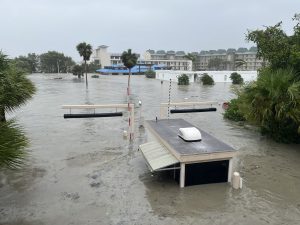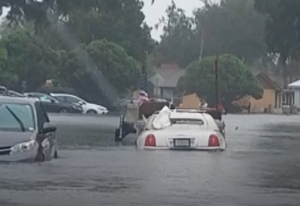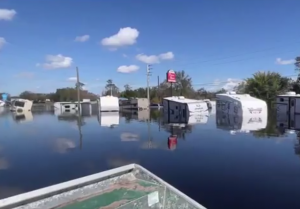Who pays?

Hurricane Ian surge in Naples along Vanderbilt Beach Road, September 28, 2022. Photo by Warren Faidley @stormchaser via Twitter
The big issue we can argue is what we don’t know about Hurricanes Ian and Nicole. How many residents and businesses had flood damage (which is not covered by most homeowners policies) and didn’t have flood insurance? And how many had flood insurance that isn’t going to provide full coverage for their loss? And how many of those with federal flood insurance are facing FEMA’s rule requiring they raise the elevation of the home and take on other mitigation measures against future flooding if repair costs exceed 50% of the home’s market value?
As we reported in our newsletter right after landfall, Ian was much more of a flood than a wind event in most areas. While those who had mortgages and lived in a flood zone were required to have flood insurance, many of the rest of the residents likely didn’t. Only 15% of Florida properties (1.6 million policyholders) have federal flood insurance (compared to 4% nationwide) even though most catastrophes involve flooding. In Lee County, where Ian came ashore, only 31% of residential structures had National Flood Insurance Program (NFIP) policies and only 51.4% of those living in Special Flood Hazard Areas (SFHA). The rate gets worse the farther inland you go where there was extensive flooding from heavy rains. The result is a massive coverage gap. One estimate says uninsured flooding could make up half of Hurricane Ian’s estimated total flood losses of $18 billion to $35 billion (the total estimated insured losses for wind and flood together are upwards of $64 billion).

Floodwaters swamp vehicles in Daytona Beach during Hurricane Ian, September 30, 2022
The road isn’t necessarily easy for those with FEMA’s NFIP policies. Insurance agents and local officials are fielding calls from homeowners with lots of coverage questions. Some are finding their losses exceed the $250,000 limit on structural damage ($500,000 for a business – see our 10 Facts About the National Flood Insurance Program). Others are running into the “FEMA 50% rule” which says if the damage exceeds 50% of a home’s market value, not including the land, it falls under newer and costlier building codes, in many cases requiring the home to be physically raised above new flood levels to prevent future damage and NFIP claims. It’s part of FEMA’s ongoing effort to eliminate Florida’s 15,000 “repetitive loss properties,” backed by U.S. taxpayers. The Sarasota Herald-Tribune reports that local government officials in Southwest Florida have been meeting with FEMA officials to relax the rules, with no success. As a result, some homeowners are finding it is cost prohibitive to rebuild.

Hurricane Ian flooding along the Peace River in Arcadia, Florida, October 6, 2022. Courtesy DeSoto County Sheriff’s Office
All of this brings us to our last question for now: How will the Florida Legislature and the federal government respond to what could potentially be thousands of flooded structures statewide left partially or totally unrepaired? Some argue we need to do more to further incentivize purchasing flood insurance, including private flood insurance which now accounts for more than 100,000 policies in the state. Some say flood coverage should be included in standard homeowners policies, perhaps starting with Citizens Property Insurance, the state-backed and now largest property insurer in Florida with 1.1 million policyholders. This is ultimately a national policy decision by federal lawmakers who must decide one question: who pays for the damage caused by Mother Nature when the time comes?
LMA Newsletter of 12-5-22


